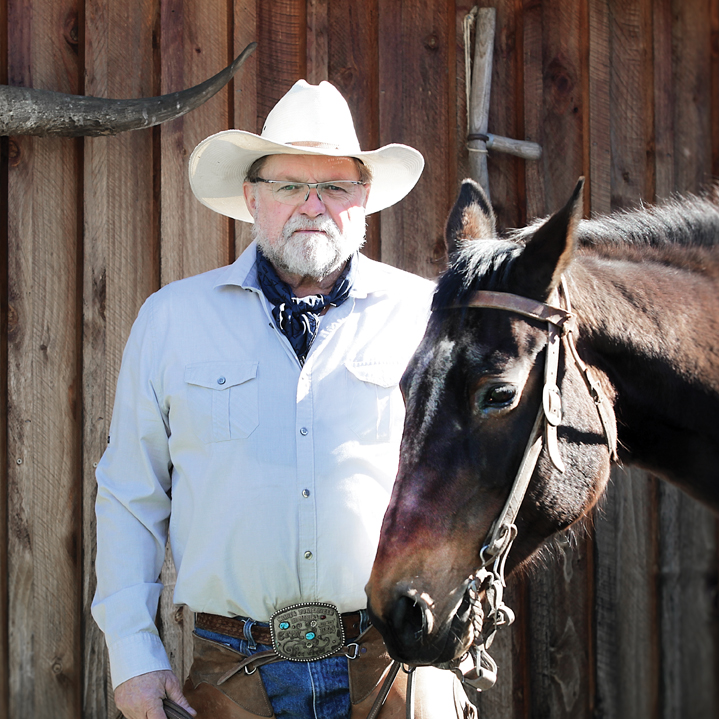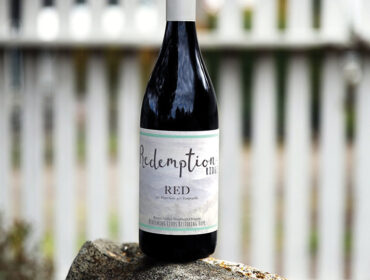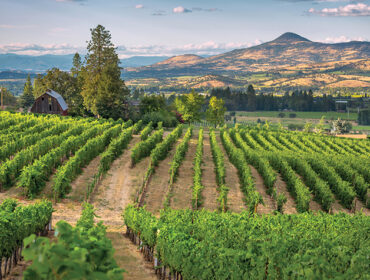
The Grape in Your Glass: The Cowboy Winemaker Propagating Heirloom Varieties at Plaisance Ranch – by MJ Daspit
For the second installment of this series on lesser known Rogue Valley varietals, Wine Scene spotlights Plaisance Ranch, where several of the eighteen wines produced under its label are unusual if not unique in Oregon. On a perfect autumn day at the close of the 2017 harvest, founding owner and winemaker Joe Ginet shared the story of how his winery evolved into an eclectic, award-winning brand, founded on one special heirloom grape.
That story begins long before Joe and his wife Suzi planted their first vines in 1998—a hundred years before, to be exact. It was in 1898 that Joe’s grandfather, the first Joe Ginet, a native of the village of St. Jean de la Porte in the Savoie region of France, immigrated to the United States following his discharge from the French army. On Sterling Creek near Jacksonville he established a homestead which he called “Plaisance Orchard.” In 1904, grandfather Joe returned to his family home in France, ostensibly to marry, but returned to Oregon with cuttings from the family vineyards instead of a bride. He propagated vines from these “sticks,” as the present day Joe aptly calls them, and prospered through the sale of his wine, fruit and grape plants. In 1912 he married a mail order bride and had five children, four daughters and a son born in 1928, two months after his father’s death. This son was also named Joe Ginet. Because he died young, the second Joe Ginet plays a limited but crucial role in the family story, that of father to the Joe Ginet who now presides over the vineyards and winery of Plaisance Ranch.
Situated on gently sloping acreage in Williams, the modern Plaisance Ranch began life as a dairy farm, but Joe dreamed of continuing the family tradition of raising vines and making wine. After thirty years of keeping milk cows, Joe sold the herd and began the process of establishing his vineyards. He began by setting up a greenhouse and propagating grape plants from cuttings just as his family in France had done for generations. Among the Ginets still residing in Savoie, Joe has three cousins in the grapevine nursery business. “Each cousin does three million grafts a year,” he explains. “So we’re talking nine million grafts a year from my family there. They make grapevines for the world.”
By 1998 the Plaisance Ranch vineyards were planted to Cabernet Sauvignon, Pinot Noir and Syrah, but getting the vineyard established was slow going because the lion’s share of the grape varieties propagated on the ranch—dozens of different clones—were sold as nursery stock. “It took us forever to get our vineyards planted,” Joe says, “because at that time the cash money from the plants was more important than getting the vineyard going.” That said, there was one variety he would never sell, the hallmark variety of Savoie that was to become the signature vintage of Plaisance Ranch—Mondeuse. It was Mondeuse that grandfather Joe had brought back from the family vineyards in France over a century ago. And it was that heritage that the modern Joe Ginet set out to honor and continue.
The Savoie wine region—it gets one page right before the section on Italy in The World Atlas of Wine (Johnson & Robinson, 7th Edition)—is alpine country bordered to the west by the upper reaches of the Rhône River, to the north by Lake Geneva and on the east by Italy. Though Savoie is predominantly known for white varietals, Mondeuse is the principal red grape of the region. Ginet refers to the Kermit Lynch Wine Merchant newsletter (March 2017) in which Anthony Lynch describes the Savoyard vineyards as “impossibly steep . . . planted at high altitudes on the rockiest soil imaginable.” Lynch describes Mondeuse as, “somewhere in between a fine cru Beaujolais and classic northern Rhône Syrah from an appellation like Saint Joseph—lively, juicy, floral, low in alcohol, and supremely elegant with a touch of meatiness you can chew on.”
“The old cobblestone road to Rome goes right through the village we’re from,” Joe adds, “and it’s where all the wars were fought. That region of France has been a part of Italy, Spain, Austria—even Ghengis Kahn was there. Everybody owned it at one time or other, so every little hill has a castle on it because that’s where they fought all the wars. Everything was decided in those mountain passes.”
The first varietal Plaisance Ranch Mondeuse was made from the 2013 harvest. Even for a hard worker like Ginet, getting to the stage where he could bottle a wine of over 75% pure Mondeuse was no picnic. The vines imported from his family vineyards in Savoie were put into quarantine in 1999 for three years at Missouri State University. “After they cleared quarantine, two dormant plants were cut up into sticks. So then you have to propagate plants from those sticks. And in three years you can cut some sticks off of those first plants that you’ve grown to make more. So you do that every year for about five years until you have enough plants to make a row. When all those plants get mature enough you can finally make a barrel of wine. The next hurdle was that the TTB didn’t recognize Mondeuse as a varietal, so I had to discuss with them that it really was. And then the wine spent two years in the barrel. The biggest ingredient in fine wine,” he adds in wildly understated fashion, “is patience. You’re talking about a fifteen year project.”
It’s little wonder that Plaisance Ranch is the only source of Mondeuse, as far as Ginet knows, in Oregon and that quantities are still quite limited. “This year we got three barrels, which is 75 cases. But we’ve planted some more so next year we may get twice that.” The winemaker smiles, “When it gets 92 points in Wine Enthusiast it kind of makes it all worth it.” That was for the Mondeuse-based blend called “Rouge Prestige” bottled in 2012, a Gold Medal winner at the 2015 Oregon Wine Experience (OWE). The 2013 varietal Mondeuse was also awarded a Gold Medal at OWE the following year.
Ginet speaks in down-to-earth terms about his winemaking style which has evolved from making garage wine in the 90’s. The high-quality is attributable to making wine in small lots so attention to detail is possible. “That’s the main thing, just attention to detail and boutique care—only 2000 cases over eighteen different wines—no huge lots, no pump-overs. It’s all pretty much old-fashioned and hands-on. I don’t think I do anything special. It’s just a combination of attention to detail and my dirt.”
With the mention of his dirt he resorts to an old saw: good wine is made in the vineyard. What does that really mean? He gives a few specifics about his site. “I’m about two to three degrees cooler than Applegate or Medford every day of the growing season. We’re a little higher up and a north-facing here whereas they’re facing south. It doesn’t seem like much, but it’s two or three degrees every day. The degree-days really add up over a season. It makes my wines different along with the dirt, of course. I have some cobbly clay here that all these grapes are grown on. It’s of average age—not young red clay or old blue clay either—with big cobble and it’s shallow, only 18-24 inches deep, then it goes right down to hardpan. During the dairy years, the vineyard site was the least productive ground we had. Now it’s the most productive.”
Another valuable attribute of his wines comes from the way the vineyards evolved from the nursery selection of some 42 different types of grapes. “I had eight clones of Tempranillo and six clones of Pinot Noir and eight clones of Syrah because in the plant business you never had what people wanted. They always wanted some designer clone. So you try to make people happy and you end up with a huge variety. But in the end I think that gives my wines some complexity because those different strains ended up in my vineyards.”
Of the eighteen different wines Ginet produces, here are three other distinctive varietals that you won’t often see on local wine lists:
Carmenère—A Bordeaux red that Ginet first bottled in 2010. Joe remarks, “I’ve never met a wine like Carmenère before. What’s interesting is that the palate does not deliver what the nose promises. You smell it and you get the fruit and a lot of really peppery green smell, but then when you taste it it’s just violets and floral and fruit—and it has a total chocolate finish.” Plaisance Ranch 2013 Carmenère earned a Double Gold at the 2016 Oregon Wine Experience competition and was #5 in the Seattle Times Top Fifty Wines of the Northwest.
Petit Verdot— A red Bordeaux that requires a long ripening season. Several acclaimed vintages come from the Columbia Valley and Walla Walla. Ginet sources this varietal from the Missouri Flat area of the Applegate. Apart from his 2015 vintage he doesn’t recall seeing a varietal bottling of it from Southern Oregon.
Petite Sirah—A red Rhône varietal now grown principally in California. Ginet explains that that the proper name for the grape is really Durif. “In the 1800’s when the French immigrants were coming into California and planting their Syrah vineyards they noticed some of the vines weren’t Syrah, but they didn’t know what they were. The clusters were smaller than the Syrah clusters so they called it Petite Sirah. For the next hundred years we called it Petite Sirah until Carole Meredith at UC Davis did DNA testing on all the varieties and figured out that our Petite Sirah is really Durif.”
As if that weren’t enough, there will soon be a new addition to the list of Plaisance Ranch’s uncommon varieties. Several years ago Ginet imported Persan, an ancient wine grape variety, all but abandoned in Savoie in favor of Mondeuse.
New York Times wine columnist Eric Asimov describes Persan in his article, “12 Wine Grapes Worth Discovering,” (24 March 2017) as a red grape once common to Savoie and Isère in eastern France that largely disappeared due to phylloxera and a root-destroying aphid. It has recently been revived by a few Savoyard growers who treasure indigenous varieties. Asimov writes, “The wine is deep, dark and almost exotically fruity, with a lovely aroma almost like pomegranate juice blended with flowers and earth.”
After four years in quarantine at UC Davis Foundation Plant Services, Ginet’s Persan may be available to plant next season. “If I get it this spring you can look for it in five or six years.”
The Persan forecast provides a fitting coda to the Plaisance Ranch story, with a winemaker’s tip of the hat to patience and the promise of a new wine unique in Oregon that will be worth the wait.
©Southern Oregon Wine Scene
Related Post
RoxyAnn Winery–Making a Difference with Redemption...
Update to this article on 07/29/21 – “… the Board of Directors of Redemption Ridge have made the difficult decision to clo...
Awen Winecraft: An Inspirational New Reason...
As if you needed another reason to visit historic Jacksonville, now there’s another draw—Awen Winecraft’s new tasting room located at ...
Rogue Valley Rising – by Valerie...
MEDFORD, OREGON’S star is rising on the world stage as it rapidly becomes a top destination for connoisseurs of fine wine and for enthusia...




